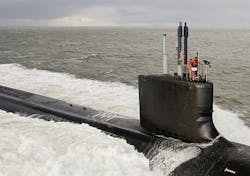L-3 to provide optical and electronic submarine masts for Navy Virginia-class attack boats
Officials of the Naval Sea Systems Command in Washington on Friday announced a $40.3 million contract to L-3 KEO to provide 16 Universal Modular Mast (UMM) systems for the Navy's Virginia-class submarine fleet.
The Virginia-class is one of the first submarines without a traditional optical periscope that penetrates the vessel's pressure hull and extends upward to enable commanders of submerged submarines to view the scene on the surface.
The UMM serves as a lifting mechanism for five different sensors including the photonics mast program, high-data-rate mast, multi-functional mast, multi-functional modular mast, and integrated electronics support measures mast.
Related: Submarine designers rely on COTS to broaden undersea warfare missions
This contract to L-3 KEO, which includes 140,000 hours of engineering services and engineering services support, has options that could bring its cumulative value to $108.4 million, Navy officials say.
The UMM is built by L-3 KEO and the company's Italian subsidiary Calzoni SrL in Bologna, Italy. On the contract announced Friday, L-3 KEO and L-3 Calzoni will do the work in Bologna, Italy, and Northampton, Mass., and should be finished by July 2017.
For more information contact L-3 KEO online at www.l-3com.com/keo, L-3 Calzoni at www.calzoni.com, or Naval Sea Systems Command at www.navsea.navy.mil.
